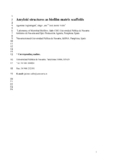Amyloid structures as biofilm matrix scaffolds
Fecha
2016Versión
Acceso abierto / Sarbide irekia
Tipo
Artículo / Artikulua
Versión
Versión aceptada / Onetsi den bertsioa
Identificador del proyecto
Impacto
|
|
10.1128/JB.00122-16
Resumen
Recent insights into bacterial biofilm matrix structures have induced a paradigm shift toward the recognition of amyloid fibers
as common building block structures that confer stability to the exopolysaccharide matrix. Here we describe the functional amyloid
systems related to biofilm matrix formation in both Gram-negative and Gram-positive bacteria and recent knowledge regarding
the interacti ...
[++]
Recent insights into bacterial biofilm matrix structures have induced a paradigm shift toward the recognition of amyloid fibers
as common building block structures that confer stability to the exopolysaccharide matrix. Here we describe the functional amyloid
systems related to biofilm matrix formation in both Gram-negative and Gram-positive bacteria and recent knowledge regarding
the interaction of amyloids with other biofilm matrix components such as extracellular DNA (eDNA) and the host immune
system. In addition, we summarize the efforts to identify compounds that target amyloid fibers for therapeutic purposes
and recent developments that take advantage of the amyloid structure to engineer amyloid fibers of bacterial biofilm matrices for
biotechnological applications. [--]
Materias
Amyloid fibers,
Bacterial biofilm matrices,
Gram-negative bacteria,
Gram-positive bacteria
Editor
American Society for Microbiology
Publicado en
Journal of Bacteriology, October 2016, vol. 198, no. 19, 2579-2588
Departamento
Universidad Pública de Navarra/Nafarroako Unibertsitate Publikoa. IdAB. Instituto de Agrobiotecnología / Agrobioteknologiako Institutua
Versión del editor
Entidades Financiadoras
This work, including the efforts of Jaione Valle, was funded by Ministerio
de Economía y Competitividad (MINECO) (AGL2011-23954). This
work, including the efforts of Íñigo Lasa, was funded by Ministerio de
Economía y Competitividad (MINECO) (BIO2011-30503-C02-02 and
BIO2014-53530-R).






